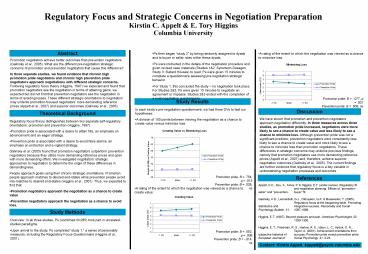Regulatory focus theory distinguishes between two separate selfregulatory orientations: promotion an PowerPoint PPT Presentation
1 / 1
Title: Regulatory focus theory distinguishes between two separate selfregulatory orientations: promotion an
1
Regulatory Focus and Strategic Concerns in
Negotiation PreparationKirstin C. Appelt E.
Tory HigginsColumbia University
Abstract
- Ps then began study 2 by being randomly
assigned to dyads and to buyer or seller roles
within these dyads. - Ps were instructed in the details of the
negotiation procedure and given revised case
materials (Studies 12 Synertech-Dosagen, Study
3 Bullard Houses) to read. Ps were given 15
minutes to complete a questionnaire assessing
pre-negotiation strategic behavior. - For Study 1, this concluded the study no
negotiation took place. For Studies 23, Ps were
given 15 minutes to negotiate an agreement or
impasse. Studies 23 ended with the completion of
a post-negotiation questionnaire.
- A rating of the extent to which the negotiation
was viewed as a chance to minimize loss
Promotion negotiators achieve better outcomes
than prevention negotiators (Galinsky et al.,
2005). What are the different pre-negotiation
strategic concerns of promotion and prevention
negotiators that cause this difference? In
three separate studies, we found evidence that
chronic high promotion pride negotiators and
chronic high prevention pride negotiators
approach negotiations with different strategic
concerns. Following regulatory focus theory
(Higgins, 1997) we expected and found that
promotion negotiators see the negotiation in
terms of attaining gains we expected but did not
find that prevention negotiators see the
negotiation in terms of avoiding losses. These
different strategic orientations to negotiation
may underlie promotion-focused negotiators more
demanding reference prices (Appelt et al., 2007)
and superior outcomes (Galinsky et al., 2005).
Promotion pride B -.077, p .001 Prevention
pride B .009, ns
Study Results
- In each studys pre-negotiation questionnaire, we
had three DVs to test our hypotheses - A division of 100 points between viewing the
negotiation as a chance to create value versus
minimize loss
Discussion
Theoretical Background
We have shown that promotion and prevention
negotiators approach negotiation differently. In
three measures across three studies, as promotion
pride increased, negotiators were more likely to
see a chance to create value and less likely to
see a chance to minimize loss. Although
prevention pride was not a significant predictor,
prevention negotiators were consistently less
likely to see a chance to create value and more
likely to see a chance to minimize loss than
promotion negotiators. These differences in
strategic concerns may underlie previous
findings, namely that promotion negotiators use
more demanding reference prices (Appelt et al.,
2007) and, therefore, achieve superior
negotiation outcomes (Galinsky et al., 2005). The
current findings are further evidence that
regulatory focus is a key variable in
understanding negotiation processes and outcomes.
- Regulatory focus theory distinguishes between two
separate self-regulatory orientations promotion
and prevention (Higgins, 1997). - Promotion pride is associated with a desire to
attain hits, an emphasis on advancement and an
eager strategy. - Prevention pride is associated with a desire to
avoid false alarms, an emphasis on protection and
a vigilant strategy. - Galinsky et al. (2005) found that promotion
negotiators outperform prevention negotiators
because they utilize more demanding reference
prices and open with more demanding offers. We
investigated negotiators strategic approaches to
negotiation to determine the origin of these
differences in demandingness. - People approach goals using their chronic
strategic orientations. Promotion people approach
matches to desired end-states while prevention
people avoid mis-matches to desired end-states
(Higgins et al., 2001). Thus, we expected to find
that - Promotion negotiators approach the negotiation as
a chance to create value - Prevention negotiators approach the negotiation
as a chance to avoid loss.
References
Promotion pride B .754, p .013 Prevention
pride B .028, ns
Appelt, K.C., Zou, X., Arora, P. Higgins, E.T.
(under review). Regulatory fit and negotiation
planning Effects of promotion-seller and
prevention- buyer fit. Galinsky, A.D.,
Leonardelli, G.J., Okhuysen, G.A. Mussweiler,
T. (2005). Regulatory focus at the bargaining
table Promoting distributive and integrative
success. Personality and Social Psychology
Bulletin, 31, 1087-1098. Higgins, E.T. (1997).
Beyond pleasure and pain. American Psychologist,
52, 1280-1300. Higgins, E. T., Friedman, R. S.,
Harlow, R. E., Idson, L. C., Ayduk, O. N.,
Taylor, A. (2001). Achievement orientations from
subjective histories of success Promotion pride
versus prevention pride. European Journal of
Social Psychology, 31, 3-23.
- A rating of the extent to which the negotiation
was viewed as a chance to create value
Study Methods
- Overview In all three studies, Ps (combined
N285) took part in unrelated-studies paradigms. - Upon arrival to the study, Ps completed study
1, a series of personality measures, including
the Regulatory Focus Questionnaire (Higgins et
al., 2001).
Promotion pride B .052, p .008 Prevention
pride B -.014, ns
Contact Kirstin Appelt, kappelt_at_psych.columbia.ed
u

